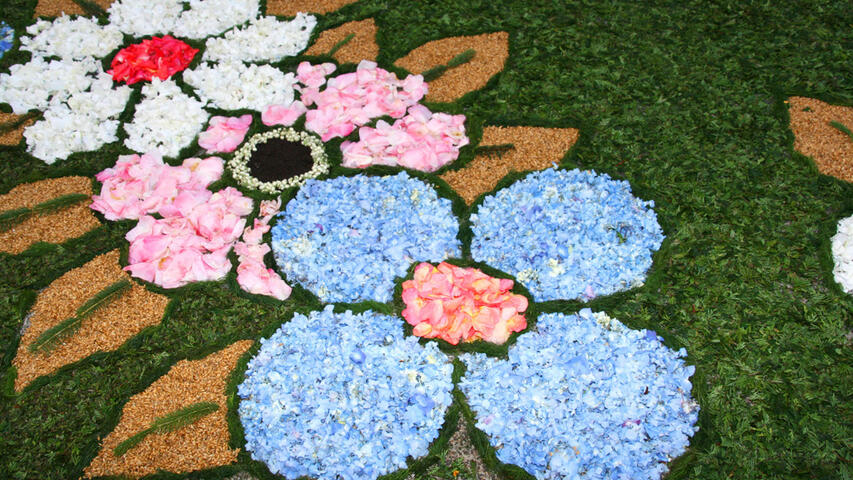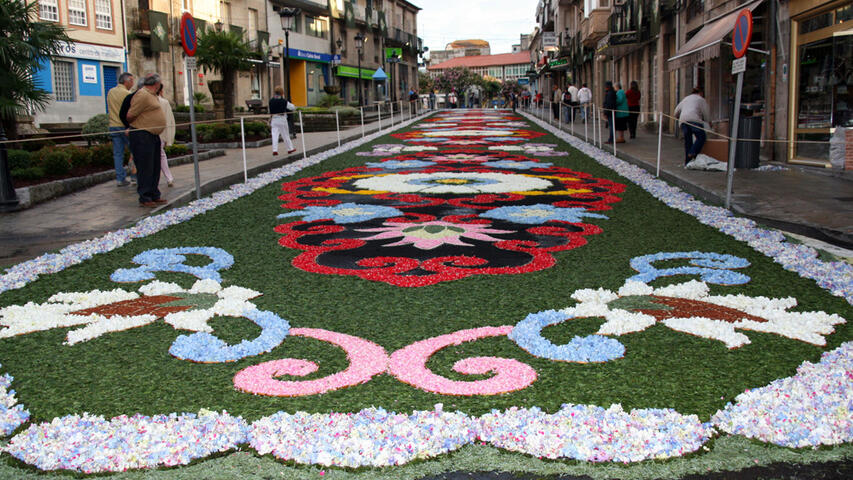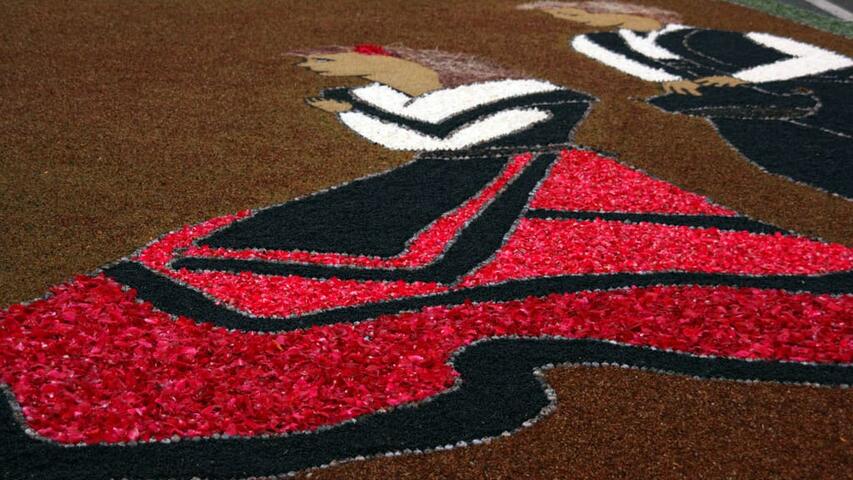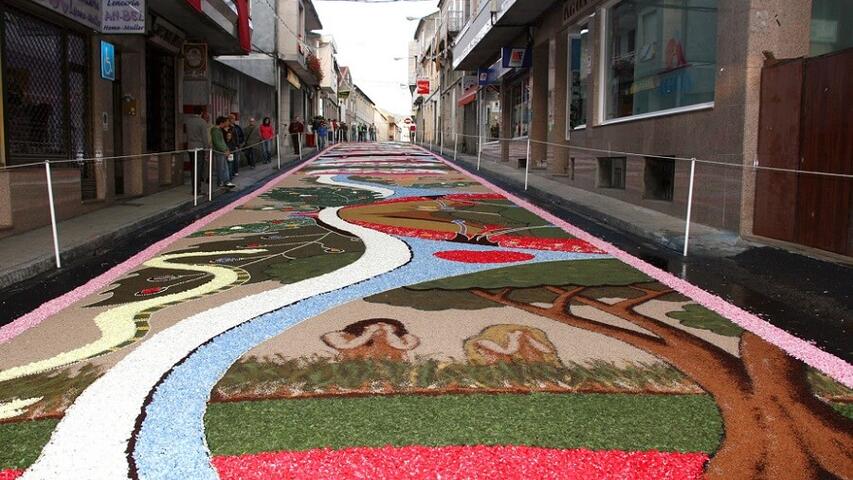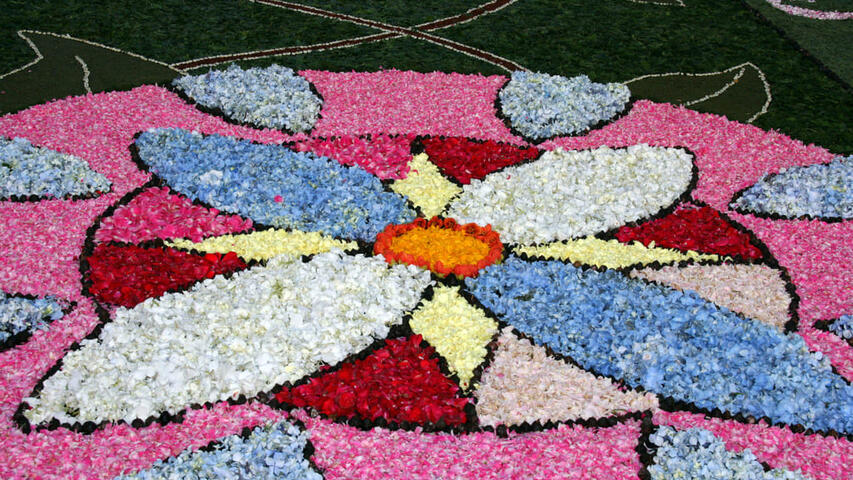Floral carpets for Corpus Christi in Ponteareas
Floral art at the foot of Ponteareas
An impressive mosaic of petals carpets the centre of the village
With minuteness. With delicacy. And, above all, with dedication. This is how the floral carpets are prepared in Ponteareas which, on the occasion of the celebration of Corpus Christi, take the name of this town all over the world. The countdown begins for a festival that combines art and religious fervour.

The Corpus Christi celebration in Ponteareas was recognised as being of international tourist interest in 2009. There are plenty of reasons for this. Those who visit this municipality for the first time will discover that art is not always at eye level. This is the case of the acclaimed floral carpets that, every year, decorate the grounds of this area of Pontevedra.
With regard to the artistic motifs that make up the canvases, those of a geometric nature and the borders, which began to be drawn in the first decades of the 20th century, stand out.
The local residents are the architects of a celebration that, since the mid-19th century, surprises those who discover it or repeat their visit to Ponteareas; more specifically since 1857, when, for Corpus Christi, the carpets cover twenty streets.
Petal rain
Hundreds of thousands of petals and flowers make up these ephemeral works of art with which the Blessed Sacrament is received. Particularly noteworthy are the final preparations from Saturday to Sunday, when the pace of work intensifies so that the carpets are ready at dawn. The spectacle of aroma and colour fills everything.
With minuteness. With delicacy. And, above all, with dedication. This is how the floral carpets are prepared in Ponteareas which, on the occasion of the celebration of Corpus Christi, take the name of this town all over the world. The countdown begins for a festival that combines art and religious fervour.
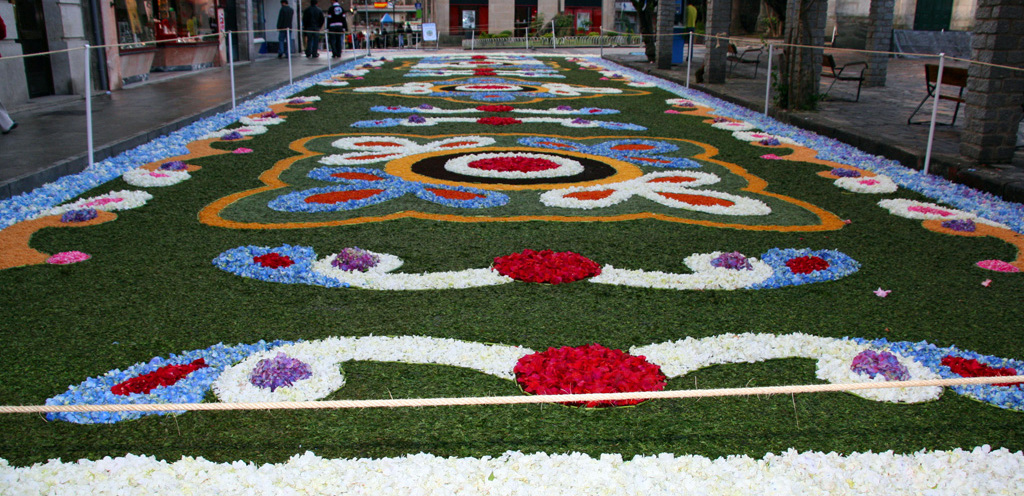
The celebration of Corpus Christi in Ponteareas was recognised as being of international tourist interest in 2009. There are plenty of reasons for this. Those who come to this municipality for the first time will discover that art is not always at eye level. This is the case of the acclaimed floral carpets that, every year, decorate the grounds of this area of Pontevedra.
With regard to the artistic motifs that make up the canvases, those of a geometric nature and the borders, which began to be drawn in the first decades of the 20th century, stand out.
The neighbours of the town are the architects of a celebration that, since the middle of the 19th century, surprises those who discover it or repeat their visit to Ponteareas; more specifically since 1857, when, for Corpus Christi, the carpets cover twenty streets.
Petal rain
Hundreds of thousands of petals and flowers make up these ephemeral works of art with which the Blessed Sacrament is received. Particularly noteworthy are the final preparations from Saturday to Sunday, when the pace of work intensifies so that the carpets are ready at dawn. The spectacle of aroma and colour fills everything.
The festivity of Corpus Christi was first celebrated in 1208 and has spread all over the world. In Ponteareas it has its own characteristics, such as the various stops during the procession. The first one takes place in the Plaza Mayor, the scene of the largest carpet. Another of these pauses takes place in San Gregorio Street, a place where a wooden cross covered with fennel used to be made. The Santísimo continues its passage accompanied by a shower of petals that, from the balconies, give shape to one of the most peculiar moments of this festivity. Ponteareas also welcomes alfombristas from other areas, including the Canary Islands town of La Orotava, which shapes a carpet with volcanic earth from Mount Teide.
Itinerary
The itinerary has key points such as Bugallal square, Oriente street, Maior square, Os Ferreiros street, Doctor Fernández de la Vega street, Reveriano Soutullo street or Constitución avenue. It should be pointed out, in this sense, that its origin is located in Abaixo Street or Real Street, extending from there to other areas.
The neighbours usually divide the task of making the carpets by doorways or ground floor, and remove the flowers for later use. Each person knows his or her role, from storing and distributing the petals to making the designs and stuffing them. The design of the stencils is the first phase of the production process, which is carried out months in advance. A few weeks before the festival, the plants are harvested, followed by the flowers. On the asphalt, on Saturday afternoon, the stencil is placed on the asphalt, which will then be covered with flowers.
In the 1990s, the "Arbomostra" wine exhibition was added and in 1996 the Fiesta de la Lamprea Seca (Dried Prey Festival) began to be held on the first weekend in July, organised by the restaurants in the municipality, which is complemented by an interesting cultural programme and activities.
